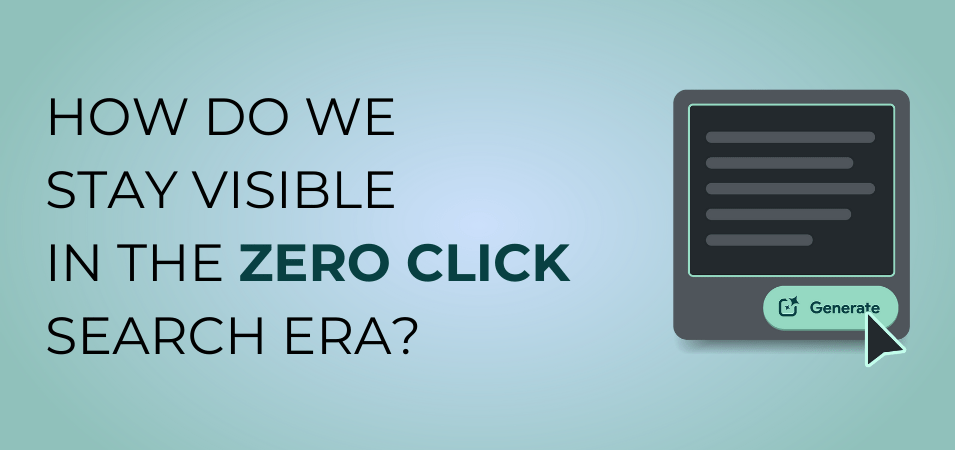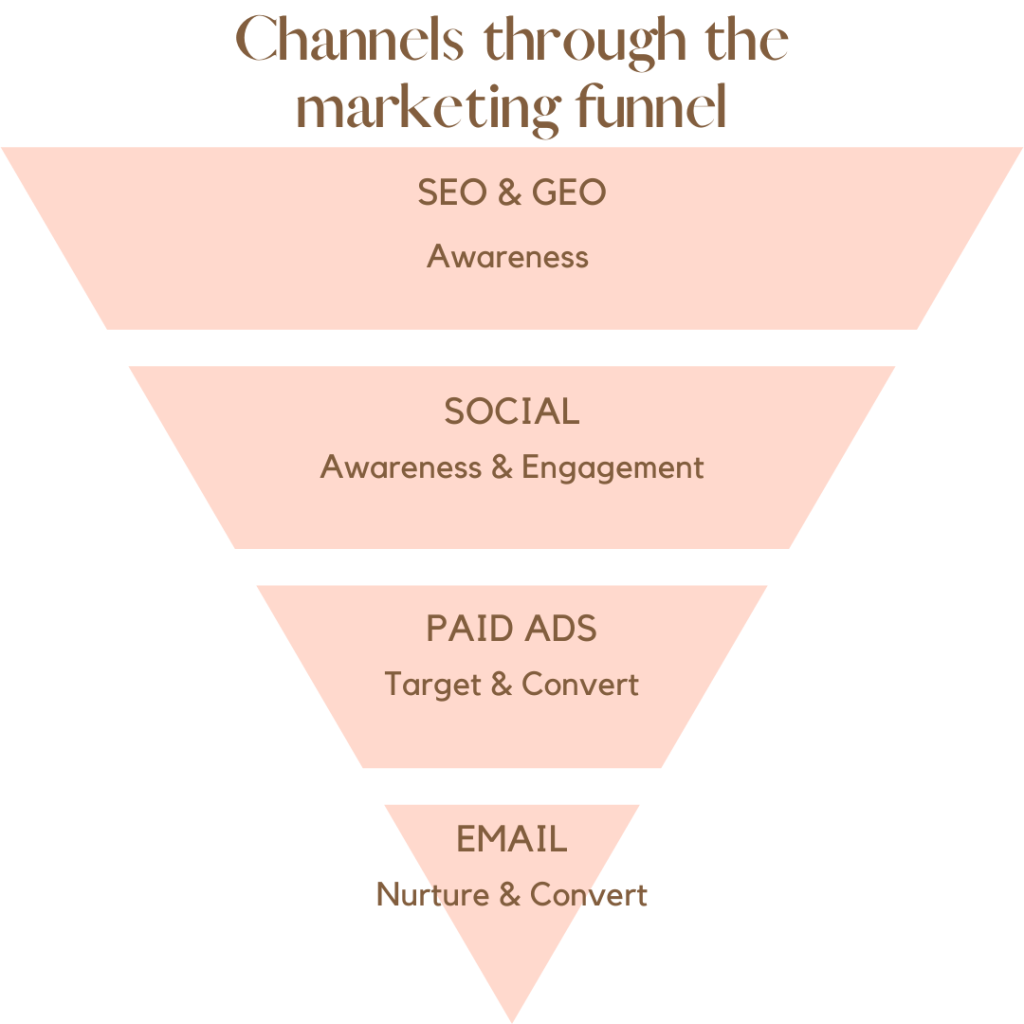
How Do We Stay Visible in the Zero-Click Search Era?
There has been a major shift in digital search landscape, influenced by the arise of Google AI Overviews, LLMs (large language models) and changing user behaviour.
Our focus to date has been on traditional SEO, focusing on page ranking and metrics such as traffic, clicks and conversions. However, with the advent of a Zero Click search we need to be wary of the inevitable decline in organic search traffic, a trend that is starting to be felt worldwide, and put strategies in place now to make sure you stay visible.
Interesting fact: In 2024 nearly 60% of Google searches end without a click (Search Engine Land 2024)
Key Takeaways
- The digital search landscape is shifting due to the rise of Google AI Overviews, large language models (LLMs), and changing user behavior.
- A “Zero Click” search environment is where users get answers directly from AI overviews or LLMs without clicking on a website. This is causing a decline in organic search traffic.
- In 2024, nearly 60% of Google searches ended without a click.
- AI Overviews are becoming more common, especially for longer, question-based queries. AI-generated search results, which synthesize information from across the web, are more prominent for these types of queries.
- Traditional SEO strategies that focus only on ranking and clicks no longer guarantee visibility.
- The goal for businesses should shift from “How do I rank?” to “How do I become the trusted source?”.
- To build authority, content should be comprehensive, clearly authored, and consistently cited within your niche. LLMs use authority signals, such as expert content evaluation, social proof, and cross-platform consistency, to choose the best content to synthesize.
- Content must be valuable, well-researched, and original to establish you as a thought leader. It should also be useful and directly answer the questions your target audience is searching for.
- A multi-channel approach is crucial, as content discovery now happens across many platforms, including social media, AI, search engines, and YouTube.
- Effective content distribution involves leveraging different channels to reach customers at various stages of their journey, moving them from awareness through to conversion.
- Winning content formats include interactive tools, AI-optimized blogs, long and short-form videos, in-depth guides, case studies, webinars, and seminars.
- Budget allocation should be re-evaluated to prioritize creating high-quality, authoritative content and using paid advertising for content amplification. As competition for ad space increases, higher ad costs are likely. The new measure of success is authority and influence, not just rank.
Zero-Click SEO: The Shifting Landscape
We are now evolving into a Zero Click search environment. This is when users get their answers directly from Google AI overviews or LLMs, such as ChatGPT & Gemini, without clicking through to any website.
AI generated search results are becoming more prominent especially for longer tail informational, or question-based queries. AI overviews from Google and other platforms synthesize information from across the web and present answers directly on the search results page. This means traditional SEO strategies that are focused solely on ranking and clicks, no longer guarantee visibility in these new formats.
Key Statistics
Source: Semrush May 2025
- AI Overviews are on the rise: 13.14% of all queries triggered AI Overviews in March 2025. Up from 6.49% in January 2025.
- Informational content is most likely to trigger AI Overviews: 88.1% of queries that trigger an AI Overview are informational.
- The number of navigational queries that trigger AI Overviews has doubled since January 2025 — from 0.74% to 1.43%.
- Industries experiencing the largest share growth of AI Overview are Science (+22.27%), Health (+20.33%), People & Society (+18.83%), and Law & Government (+15.18%)
The impact on the user journey
User behaviour is also changing. Previously users followed a clear funnel – search > click > explore > convert. Now AI-driven platforms enable more complex and non-linear paths. LLMs like ChatGPT guide users through discovery, evaluation, and even decision-making without ever sending them to a website.
Average session times are significantly longer: ~6.5 minutes on ChatGPT and 12 minutes on Perplexity, compared to under 2 minutes on Google. This signals that users are engaging more deeply within AI interfaces.
What does this mean for your digital strategy?
For businesses, this raises major questions: If customers make decisions without ever reaching your site, how do you influence them? How do you measure success?
| What’s Changing | What remains true |
| How users search
More conversional and questions |
Quality Content Wins
Helpful, accurate information is still king |
| Where answers appear
Users get answers directly in LLMs or AI Overviews, even social media |
Authority matters
AI prioritises established credible sources |
| How We Measure Success
Being referenced matters more than being clicked |
User Intent is Key
We need to understand more than ever what people want and provide content that will directly address their needs. |
The key is to adapt content for the environments where users are making their decisions.
These are the priorities to focus on in this new landscape:
1. Building credibility & authority
With this fundamental shift in the search landscape the question isn’t “How do I rank?” It’s “How do I become the trusted source?” Trust in this new landscape is about being the most comprehensive, clearly authored, and consistently cited source within your niche.
LLMs use authority signals to help them decide the best content to synthesize, such as expert content evaluation, social proof inventory and cross platform consistency. What this means is they are looking to see if you have experts from your business that are mentioned elsewhere; are there other people mentioning you and commenting that what you say is true; is your message consistent across all channels.
Therefore, we need to keep in mind that content produced & promoted, effectively leverages these authority signals.
2. Covering topics more deeply and that match user intent
We need to continuously create valuable, well-researched, and original content that establishes you as a thought leader. This content should naturally attract expert citations and social sharing, further reinforcing your authority in the eyes of LLMs. Content needs to be useful and directly answers the questions your target audience are searching for.
3. Diversify channels and distribute content widely
In conjunction with the shift in search, content discovery now happens across all platforms, in the past it was mainly search engines, now people are using multiple surfaces to search (Social Media, AI, Search Engines, You Tube etc). It is well supported across various marketing circles that the average person engages with your brand many times before converting, this means you need to reach them multiple times across different channels before making a decision.
The message here is we need to create more content and distribute it widely across the channels your customers are showing up on so that you meet your customer in the right stage of their customer journey.
We recommend smart content that will go further and have great interactivity and engagement.

SEO and social media to build initial awareness and introduce potential customers to your services. As they move into the middle of the funnel, social media and targeted ads work together to nurture their interest and engagement.
Finally, email marketing is crucial for converting your warmest leads, taking them from the middle to the bottom of the funnel for the ultimate conversion.
The key is to take the content from the awareness stage and pull it through the rest of the funnel by leveraging the different channels so you can better nurture through the middle and bottom of the funnel
Channels to focus on in 2025 and beyond
To thrive, it will be important to adopt a multi-channel approach that builds authority and engages users wherever they are. The focus is on creating high-value content and distributing it effectively.
- AI-Optimised Articles and Blogs: Create in-depth, expert-led content that serves as a primary source for AI Overviews. The goal is not just to rank, but to be the definitive answer to your audience’s most important questions, demonstrating clear expertise and authoritativeness.
- Organic Social Media: Use platforms like LinkedIn, Instagram, and Facebook to build a community and generate social proof. Engaging with your audience here creates brand advocates and sends strong authority signals that AI models recognise.
- Paid Advertising: As organic reach becomes less predictable, paid advertising across search, social, and print platforms guarantees visibility. Digital advertising allows for precise targeting to amplify your best content and capture conversions, while print can build broad brand awareness and credibility.
- Email Marketing: This is your most direct line to your most engaged audience. Continue to use email to nurture the relationships built on other channels, distribute your most valuable content, and guide warm leads toward conversion.
Winning content formats
- Interactive formats such as calculators & tools
- SEO & AI Optimised blogs, focusing on fresh unique and actionable content
- Long and short form video – long form is good for channels such as Linked In and You Tube, short form for social media
- In-depth guides and whitepapers
- Case Studies
- Webinars & Seminars
Budget considerations
This strategic shift from traditional SEO to a broader authority-building model has direct implications for budget allocation. Success in this new landscape requires a reallocation of resources toward higher-value activities.
- Increased Investment in High-Quality Content: Creating authoritative, expert-driven content is more resource-intensive. Budgets should account for subject matter experts, skilled writers, video production, and graphic design to produce the ‘winning content formats’ that establish you as a thought leader. Budgets should be aimed towards content creation, distribution, and promotion. The new ROI is measured in authority and influence, not just rank.
- Allocation for Content Amplification: A significant portion of the budget should be dedicated to paid advertising. As organic click-through rates decline, paid channels become essential for amplifying your content, guaranteeing reach, and driving targeted traffic.
- Prepare for Higher Ad Costs: As more businesses shift focus from organic SEO to paid channels, competition for ad space will intensify. This will likely drive up advertising costs. Budgets must be planned with this potential increase in mind to maintain a consistent level of visibility.
The goal is not necessarily a larger budget, but a smarter, reallocated budget that invests in building a long-term, resilient brand asset: your authority.
In conclusion
The digital landscape is undergoing a fundamental transformation. The era of relying solely on ranking is over, replaced by an environment where answers are delivered directly by AI. This represents the most significant shift in user behaviour in over a decade.
To succeed, businesses must evolve their strategy from chasing clicks to building authority. This means becoming the most trusted, comprehensive, and cited source in their field.
The focus moving forward must be on a holistic, multi-channel approach centred on creating exceptional, expert-led content. Content is then distributed across social media, paid channels, and email to engage audiences at every stage of their journey. By doing so, you not only adapt to the new reality of search but also build a more resilient brand and a more direct, valuable relationship with your customers.

